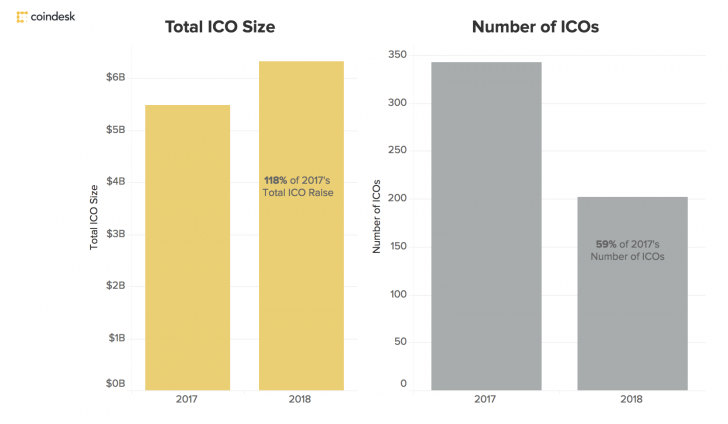Security Tokens: The Next Crypto Revolution

Jon Carr-Harris
over 5 years ago

With 834 ICOs achieving a total raise of $6.13 billion, 2017 marked the year of ICOs. And according to CoinDesk, Q1–2018 has already surpassed the entire 2017 figures by 118 percent.
The above success proves that this new fundraising technique is here to stay.
But the majority of these ICOs issued utility tokens, which would preclude them from having to follow the securities laws and regulations across the globe. Complying with the regulations for a security launch was a non-starter as it would have been too onerous and expensive for startups. But the Securities and Exchange Commission (SEC) has started knocking on the doors of these “utility” ICOs and depending on their token characteristics has had them suspend their token offerings.
Many blockchain commentators have come out and shared the obvious- utility tokens do not have underlying value and are too similar in characteristics to a security.
Blockchain entrepreneurs have taken up the challenge, and 2018 has seen the advent of Tokenization- where physical assets are onboarded on the blockchain to allow their trading as Securities. The integration between the traditional finance world and the disruptive blockchain technology is possible through the tokenization of securities. Even more than ICOs, it is the TAOs (Tokenizes Asset/Securities Offerings) which will open a new chapter in the world of traditional finance.
 Source: Coindesk
Source: Coindesk
Security Tokens
As the blockchain industry evolves, security token provides an opportunity to the crypto enthusiasts, institutional investors and issuers to become a part of this ecosystem.
Security tokens enable organizations to raise funds through issuing tokens on the blockchain that are backed by a financial asset or instrument such as an asset, equity or revenue of the company. Security tokens abide by the securities laws and also provide legal protection to the contributors (something not possible with a utility token which is more of an invest and pray type of a scheme).
The security token derives its monetary value from an external, tradable asset. These tokens are also known as investment tokens as the investors buy the tokens of the company in the expectation of future profit. The characteristics about the financial rights provided to the investor are written in the Smart Contract, and the tokens can be traded like normal tokens on a blockchain exchange.
Advantages of Tokenizing of Real World Assets
There are trillions of dollars of assets in the marketplace that can be tokenized with the power of securities token. Security tokens have an advantage over traditional financial products as they promise to increase the liquidity of global private assets such as equity, debt, real estate, precious metals/artifacts and provide access to funds at a lower cost of capital. They are also alluring to the investors because they use decentralized blockchain technology, they have a global reach and eliminate intermediaries. These assets are divided among several investors in the form of tokens.
Let us understand through a case:
An accredited investor acquires the Hope Diamond for an investment, anticipating future profits by the time he decides to sell.
During the time of purchase, the investor has to go through a long and complicated process with lawyers, verification intermediaries, insurance, packaging, and transportation involving enormous costs and time. Moreover, in the future, if the investor wishes to sell it, he has to again go through the whole process.
A limited number of buyers is also a significant issue as very few would have resources to buy the diamond. Finally, the investor has to sell it at a deep discount because of its illiquid nature. This deep discount is called the illiquidity discount. Moreover, the investor cannot sell the diamond in case of emergency because it is not a liquid asset.
But consider if, after buying the diamond, the investor tokenized the asset and created one million tokens which he sells to investors. Now, what has changed?
A) He can sell a partial ownership interest in the diamond. Any buyer in the fiat world would have demanded full ownership.
B) The investor can sell at a higher price as he can now target millions of accredited investors as compared to looking at a tiny group of people who could hope to buy such a marquee asset in its entirety and would have demanded an illiquidity discount.
C) He can liquidate the rest of his holdings as and when required. He can also offer to buy back the existing tokens, at a price the market is willing to sell back to him.
Securities token will provide liquidity solutions by changing the way these assets are bought and sold by eliminating the middlemen. In the tokenization of securities, there would be millions of digital tokens that would represent a share/piece of the underlying asset. Most importantly, it will bring onto the market the opportunity to buy and sell trillions of dollars of private assets that had no chance of creating liquidity for their owners by themselves.
These security tokens will be traded openly in the market and will allow frictionless trading of assets providing many advantages.
• Access to a broad investor base and global pool of capital • Fractionalization of Larger Assets • ncreased Liquidity • Lower processing fees • Elimination of Intermediaries and Transparency • Automated and Faster Deal Execution • Bringing Credibility to Accredited Investors to Invest in Private Securities Offerings
Security Tokens or Utility Tokens?
A utility token is structured to not be a security. By definition, it is designed to be used in the ecosystem of the business and has no underlying value. It empowers user participation by access to products or services offered by the company, incentivizes the community and enables transparency in operations. So what is the technical difference between the two?
The most crucial factor in deciding whether a token is a security or a utility token is its intended use and functionality. If the purpose of token issuance is an investment, wherein growth in the underlying asset or the company will provide token-holders with the dividend, ownership rights, appreciation profits, then the tokens are considered as security tokens. Utility tokens are issued to give token-holders access to the company’s platform and buy its products or services.
The SEC uses the Howey test to determine the validity of the contract as an investment contract. There are two questions either of which needs to be answered “yes” for qualifying as a security token.
**Question 1: ** Does the token give a right to the token holders to share in profits? Is the token being sold as an investment?
**Question 2: ** Does the offering involve generating profits from the work of individuals other than the creators or founders of the project? Is there a person upon whom investors rely?
A token is deemed to be a security token if it fulfills the following four prerequisites:
Investment of money is involved. The money is invested with the expectation of profit. The money invested is in a common entity. The profit is generated through the efforts of individuals/promoters or a third party. SEC follows the concept of “substance over form” which gives importance to the economic realities about the investment rather than its legal form. Therefore, utility token may be created only for usage, but the fact is that contributors invest in anticipation of appreciation.
Regulations:
The U.S. Securities and Exchange Commission (SEC) rolled out subpoenas to 80 ICO companies in March, including major players like tZero and TechCrunch. SEC suspects these unlawful token offerings and trading with the belief that most of the tokens issued by the companies are security tokens in the guise of utility tokens.
Organizations issuing security tokens will be able to protect themselves legally and will provide investors a measure of certainty about their investments. This is the precursor for attracting institutional investors who have been waiting on the sidelines for a compliant offering which has underlying value. Tokenization solves both the issues.
In the US, the token issuers need to usually follow the three regulations mentioned in the SEC Act 1933- Regulation D, Regulation A+, and Regulation S.
Regulation D:
Any offer or sale of securities must either be registered or exempted as per federal securities law. The regulation allows smaller companies and entrepreneurs to sell the securities without registering with the SEC. However, the companies have to fill “Form D” after they sell their securities for the first time. The exemptions are established under Rule 504 and Rule 506.
Rule 506c allows the companies to sell securities to an unlimited number of “accredited investors” and verifies that the information provided by the organization is accurate and not misleading.
Regulation A+:
This exemption authorizes organizations to issue securities to non-accredited investors in the form of two tiers of offerings:
• Tier 1 — Up to $20 million offerings in securities in a 12 month period.
• Tier 2 — Up to $50 million offerings in securities in a 12 month period.
Regulation A+ has significant time and cost attached to it but is worth the effort if you are looking to raise backing from a broad set of people. An offering statement Form 1-A is to be filed with the SEC, which would include notification, offering circular and exhibits. The offering circular comprises audited financial statement, information about the issuer, any underwriting discounts and commissions, a summary of risk factors, etc.
Regulation S:
The regulation states the rules that govern the sale of securities made outside the US wherein; the companies are not liable to the registration requirements of Section 5 of the Securities Act, 1933. Regulation S permits two types of transactions:
(i) A U.S. company issuing securities only to foreigners; and
(ii) A U.S. investor buying foreign securities by entering a foreign market.
Types of Security Token:
1) Share-like tokens are equity tokens where the token holders have the financial right to ownership in a company, voting rights, limited partnership shares, dividends, and the share of profit or revenue.
Some examples are: Blockchain Capital, wherein the token holders have a share in the profits earned by the company. Another is 22X fund. This token enables the investors to own up to 10% equity of the startups.
2) Asset-backed tokens give the economic right to the token holder to a real-world asset, such as art, real estate, power plants, precious metals, etc.
Few asset-based security tokens are already going strong in the blockchain universe:
A Case Analysis: Real Estate Security Tokens.
Security tokens backed by real estate aim to fractionalize real-world assets like commercial buildings, condos, warehouses etc. It allows the owner of the asset to sell its illiquid asset by splitting it and trading it off as equity/shares in the form of tokens. Many cryptocurrency projects centered towards improving the traditional real estate industry are emerging in the crypto-ecosystem.
Leading Players:
Property Coin / PCX
It is an investment vehicle backed by a real asset. It is the first crypto token that uses blockchain technology to securitize real estate portfolio. The profits are reinvested in properties to naturally increase the value of the tokens in the secondary market.
Amount Raised: The Company seeks to raise $50M via Security Token Offering (STO).
SwissRealCoin / SRC
The token aims to disrupt the real estate asset management industry with the blockchain technology by initiating transparency, data integrity, and cost efficiency.
Amount Raised: The Company seeks to raise $30M CHF soft cap via Security Token Offering (STO) and 160,500,000 SRC as a hard cap.
These tokens represent the first major attempt at bringing private real estate into the ambit of the blockchain. With security tokens protecting their interests, the industry should witness an influx of accredited investors and traditional institutional investors infusing money.
Process of Tokenization:
The tokenization ecosystem involves platforms, exchanges, issuers, contributors, advisors, lawyers, liquidity providers and more.
Though the legal process, timelines, and costs for tokenization are comparatively higher than a utility offering, it is worth the investment for the long-term benefits that accrue to a company which is willing to go through the compliance process.
Issuance Platforms: To eradicate the cumbersome process of token issuance and to allow investors to trade independently, platforms like Polymath, Harbor and Securitize seamlessly enable tokenization.
Exchanges: Exchanges will allow a platform to the investors to trade in the security token. It will disrupt the existing security market and let companies trade their own tokenized securities. Some of the prominent current security token exchanges: tZero, Open Finance Network (OFN), Orderbook.
Liquidity Layers and Solution Providers: Platforms like Bancor, Airswap provide innovative liquidity solutions to the issuer.
Tokenization has a broad scope, and STOs will emerge and prove to be the real competitor to the traditional IPOs.
The market cap of the security tokens is expected to reach $10 trillion by 2020. Though the number seems too optimistic, even achieving a fraction of the target would reshape the financial services industry forever.
This article was published on Swish.com and brought to you by the Swish Blockchain team ⛓.